Every year as the draft approaches I like to look at different trends over the last five years to see how teams can better utiltize the draft and free agency to build their football team by taking a bit of a more data based approach to player availability and success.
The first thing I did was go back to 2020 and look at the top 20 contracts at every position in the NFL. I then determined of those top 20 players how many of those players were available in free agency when they signed their most recent contract. This can give us a strong indication of good veteran players who a team can “buy” to become a starter.
The second thing is to look at the contractual benefit that exists if we hit on a player in the draft. To do this I looked at what the 16th pick in the NFL draft will cost (about $4 million a year) and what annual savings that would provide over the 10th highest paid player at each position in 2024. Here are the results:
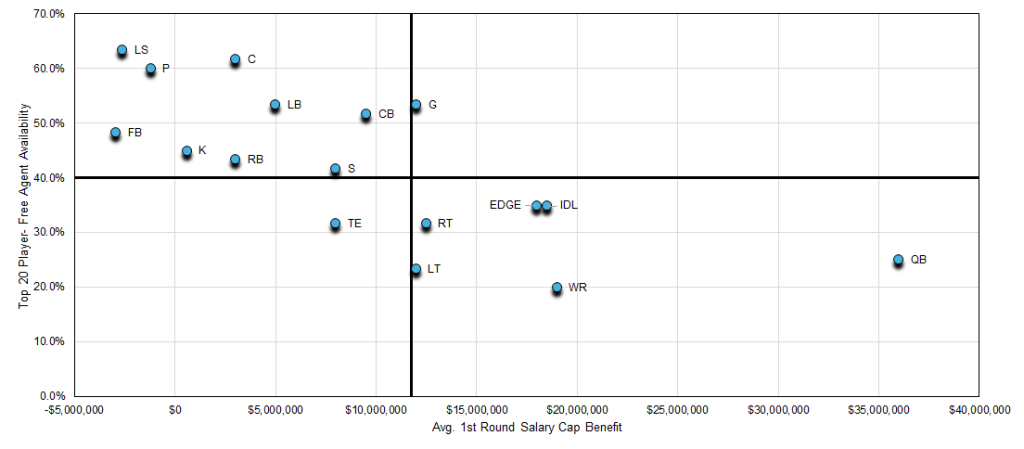
The positions in the bottom right quadrant are the positions that teams really should be focusing in the top rounds of the draft. These are positions with poor free agent availability along with massive contractual savings if the player hits. Those contractual savings are not just important for being able to “buy” players but they also give a safety factor to each pick.
For example a $4 million EDGE would be around the 59th highest paid EDGE in the NFL. That means that to justify his salary all he has to be is a situational type player. While that may be a disappointing outcome for a 1st round pick, the fact will be that the team is not losing money and/or cap room in the process. A linebacker, in comparison, would rank around 33rd meaning you need a borderline starter to justify the salary. Tight end would be 25th so that player has to be a starting quality player.
For whatever reason I think we have a hard time grasping the concept that sometimes drafting the “best available player” based on traditional scounting grades does not always equal building the best 53 man roster. When we discuss tight end vs wide receiver for instance the draft decision has a major bearing on the overall quality of the roster. If I draft a tight end at $4 million a year my team is saving about $8 million a year in salary cap charges if he hits. With that $8 million the team can buy someone like Zay Jones, Hollywood Brown, or Robert Woods.
If I draft the wide receiver and he hits I will save about $19 million. With that $19 million I can purchase someone like a Dalton Schultz or Noah Fant and still have $9 million or so to spend to maybe sign someone like Andre James at center or Blake Cashman at linebacker. You get more access to talent by selecting the premium position even if that player doesn’t grade as highly.
The top left quadrant are the positions that probably should never be drafted in the first round as these are the positions where we have free agent availability and limited salary savings. You can let someone else draft these players high and then sign them as free agents.
The two oddball positions are tight end and guard. Tight end has shifted in the last few years in terms of availability. While salaries remain stagnant and there is no salary benefit to drafting a tight end, more and more teams are extending their tight ends which makes them harder to buy in free agency. I am not sure if this is a byproduct of the low cost of the position or the trend that went on for a few years where tight ends switch teams after mediocre rookie contract runs and then play above their rookie levels. I would lean toward the latter because that cost has not changed the way we approach positions like safety.
Guard salaries have exploded and are now on par with the tackles. So there is a salary cap benefit to selecting a guard, however teams are allowing the players to hit free agency even though the markets view them as top players at the position. Neither position should be taken in the first round, but there is at least an argument that can be made.
I think it is also worth pointing out the cornerback position. Stagnant salaries have moved the position out of the aboave average cap savings category and teams continue to let their corners leave in free agency. I do believe in most cases a corners best years are years two through four or five and that is the reason why team’s are not going out of their way to extend their draftees. That can make this a position worth drafting but knowing it is a short term not long term solution.
The other area that we need to look at when crafting a draft strategy is where do top players come from. For example if we look at QB it is pretty clear that drafting a player high is a risk you have to take. The average draft round in any given year for a top 20 paid QB is 1.8 and nearly 70% of the players are first round picks.
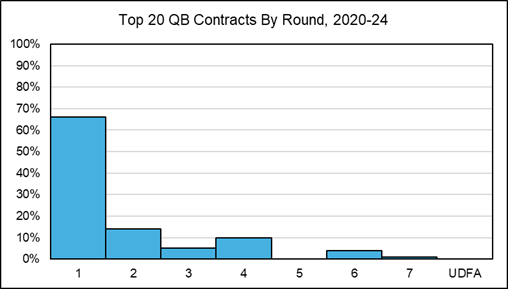
The round by round success is also a reason why you can justify devaluing the need to draft a wide receiver in the first round even though the original chart shows that selection as a better pick than an EDGE. Here is the receiver breakdown by round:
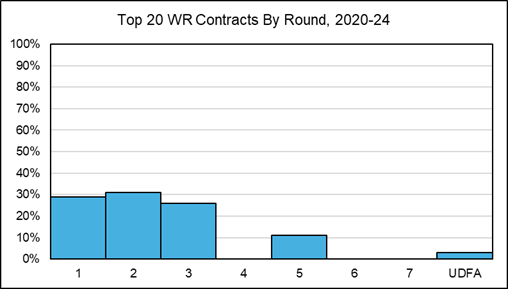
Now here is EDGE.
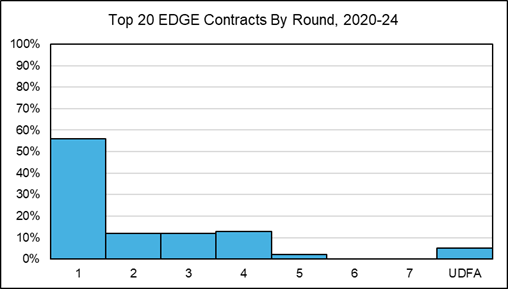
Basically by looking at past results we are bringing a 3rd dimension into the decision making process. We know that receiver is a position you have to draft due to lack of availability but it’s a position with talent in the first three rounds . EDGE has nearly 60% of the top players coming off the board in round 1 which is a reason to strongly weigh the pass rusher over the receiver in round 1 since we have seen so many very good receivers fall into the 2nd and 3rd rounds. .
At the other end of the spectrum are positions like center where the average draft round is 4.4 and we can find higher level players in most rounds.
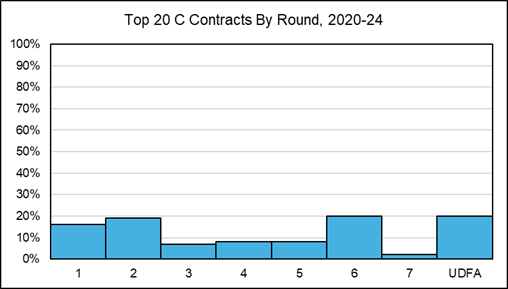
The positions that are just a waste to select in any round are the special teams positions where the average draft rounds of a top player are around the 7th round.
Here is the breakdown for the top 20 contracts looking at the average draft position and the breakdown by round of the draft from the last five seasons.
| Position | Round 1 | Round 2-3 | Rd 4-7 | UDFA | Avg. Round |
| QB | 66.0% | 19.0% | 15.0% | 0.0% | 1.80 |
| LT | 61.0% | 25.0% | 12.0% | 2.0% | 2.10 |
| EDGE | 56.0% | 24.0% | 15.0% | 5.0% | 2.18 |
| IDL | 56.0% | 31.0% | 13.0% | 0.0% | 1.95 |
| CB | 48.0% | 35.0% | 6.0% | 11.0% | 2.43 |
| RT | 45.0% | 29.0% | 14.0% | 12.0% | 2.84 |
| G | 32.0% | 47.0% | 16.0% | 5.0% | 2.62 |
| RB | 29.0% | 43.0% | 18.0% | 10.0% | 2.97 |
| WR | 29.0% | 57.0% | 11.0% | 3.0% | 2.48 |
| S | 25.0% | 44.0% | 30.0% | 1.0% | 2.94 |
| LB | 24.0% | 47.0% | 25.0% | 4.0% | 2.96 |
| TE | 17.0% | 41.0% | 32.0% | 10.0% | 3.53 |
| C | 16.0% | 26.0% | 38.0% | 20.0% | 4.41 |
| K | 0.0% | 0.0% | 46.0% | 54.0% | 7.05 |
| FB | 0.0% | 0.0% | 35.6% | 64.4% | 7.21 |
| P | 0.0% | 6.0% | 50.0% | 44.0% | 6.43 |
| LS | 0.0% | 0.0% | 9.0% | 91.0% | 7.81 |
I think by putting it all together we can come up with some strategies as to where to focus in each round. For each position a green means a very good option for the round, yellow is one you can argue, and red means you should just avoid that position at that point.
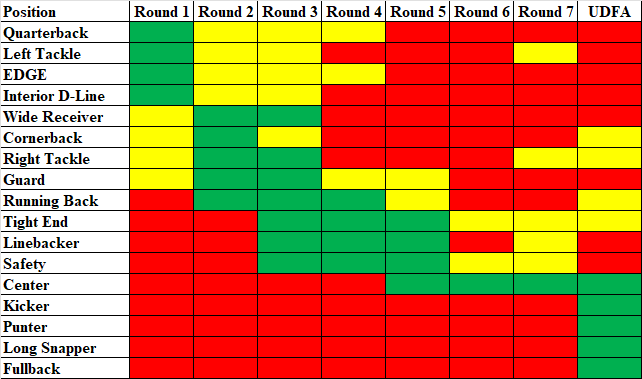
As always there are going to be exceptions to everything and you can make what you want with the numbers but teams should be using these past results regarding availably, salary benefits of a draft pick, and rookie success by round and using that to optimize their approach to building a team. Avoiding these things and assuming that you will always hit big no matter who you draft and that the other parts will somehow magically come together even though there is little data to support finding those other parts in free agency is going to lead to a rough run for the organization.